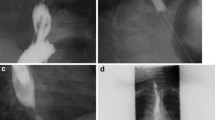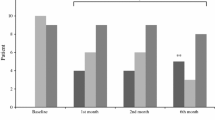Abstract
One of the most serious problems in patients with long-gap esophageal atresia or corrosive esophagitis is esophageal stricture, which may require esophageal resection and replacement. We describe two cases with persistent esophageal stricture successfully managed by high dose intravenous methylprednisolone following balloon dilatation. High-dose methylprednisolone with gradual tapering (daily 25, 15, 10, 5, 2 mg/kg for 4 days each) plus cimetidine and ampicillin for 1 week was intravenously administrated immediately after balloon dilatation of the esophageal stenosis. This was followed by oral prednisolone (daily 2, 1, 0.5 mg/kg for 1 week each) for persistent esophageal stricture. High dose intravenous methylprednisolone therapy was given to two patients. One patient was a 5-year-old boy with long-gap esophageal atresia who had undergone repair of the esophagus resulting in severe anastomotic stenosis of 3 cm in length. The other case was a 10-year-old boy with corrosive stenosis caused by alkali ingestion. Both patients had been requiring balloon dilatation of the esophagus with intralesional injection of dexamethasone every 3 weeks for more than 1 year to tolerate oral feeding. After the high-dose methylprednisolone protocol was initiated, the symptoms of dysphagia or choking dramatically improved in both patients, and they remained symptom-free for 8 and 7 months. There were complications of moon faces that resolved concomitantly with the withdrawal of oral prednisolone in both cases. High dose intravenous methylprednisolone in addition to intralesional injection of dexamethasone following balloon dilation is an effective therapeutic strategy for persistent esophageal strictures.



Similar content being viewed by others
Abbreviations
- GER:
-
Gastroesophageal reflux
References
Haller JA (1979) Corrosive strictures of the esophagus. In: Ravitch MM, Welch KJ, Benson CD et al (eds) Pediatric surgery, 3rd edn. Year Book Medical, Chicago, pp 472–475
Tunell WP (1986) Corrosive strictures of the esophagus. In: Welch KJ, Randolph JG, Ravitch MM et al (eds) Pediatric Surgery, 4th edn. Year Book Medical, Chicago, pp 698–703
Gandhi RP, Cooper A, Barlow BA (1989) Successful management of esophageal strictures without resection or replacement. J Pediatr Surg 24:745–749
Berenson GA, Wyllie R, Caulfield M, Steffen R (1994) Intralesional steroids in the treatment of refractory esophageal strictures. J Pediatr Gastroenterol Nutr 18:250–252
Altitas E, Kaar S, Tunc B, Sezgin O, Parlak E, Altiparmak E, Saritas U, Sahin B (2004) Intralesional steroid injection in benign esophageal strictures resistant to bougie dilation. J Gastroenterol Hepatol 19:1388–1391
Ramage JI, Rumalla A, Baron TH, Pochron NL, Zinsmeister AR, Murray JA, Norton ID, Diehl N, Romero Y (2005) A prospective, randomized, double-blind, placebo-controlled trial of endoscopic steroid injection therapy for recalcitrant esophageal peptic strictures. Am J Gastroenterol 100:2419–2425
O’Neill JA Jr, Betts J, Ziegler MM, Schnaufer L, Bishop HC, Temleton JM (1982) Surgical management of reflux strictures of the esophagus in childhood. Ann Surg 196:453–460
Hicks LM, Christie DL, Hall DG, Cahill JL, Mansfield PB, Stevenson JK, Bill AH (1980) Surgical treatment of esophageal stricture secondary to gastroesophageal reflux. J Pediatr Surg 15:863–868
Miyashita M, Onda M, Okawa K, Matsutani T, Yoshiyuki T, Sasajima K, Kyono S, Yamashita K (1997) Endoscopic dexamethasone injection following balloon dilatation of anastomotic stricture after esophagogastrostomy. Am J Surg 174:442–444
Takamizawa S, Yamanouchi E, Muraji T, Nishijima E, Satoh S, Tsugawa J (2007) MCRA of an anastomotic stenosis after esophagoesophagostomy for long gap esophageal atresia: a case report. J Pediatr Surg 42:769–772
Anderson KD, Rouse TM, Randolph JG (1990) A controlled trial of corticosteroids in children with corrosive injury of the esophagus. N Engl J Med 323:637–640
Ulman I, Mutaf O (1998) A critique of systemic steroids in the management of caustic esophageal burns in children. Eur J Pediatr Surg 8:71–74
Boukthir S, Fetni I, Mrad SM, Mongalgi MA, Debbabi A, Barsaoui S (2004) High doses of steroids in the management of caustic esophageal burns in children. Arch Pediatr 11:13–17
Cadranel S, Scaillon M, Goyens P, Rodesch P (1993) Treatment of esophageal caustic injuries: experience with high-dose dexamethasone. Pediatr Surg Int 8:97–102
Carrico TJ, Hehrhof AL, Cohen IK (1984) Biology of wound healing. Surg Clin North Am 64:721–733
Appelqvist P, Salmo M (1980) Lye corrosion carcinoma of the esophagus: a review of 63 cases. Cancer 45:2655–2658
Acknowledgments
The authors thank Paul D. Danielson MD for reading the manuscript and helpful discussions.
Author information
Authors and Affiliations
Corresponding author
Additional information
A written informed consent was obtained from the parents for submitting the manuscript. This study has been performed with the ethical standards laid down in the 1964 Declaration of Helsinki.
Rights and permissions
About this article
Cite this article
Morikawa, N., Honna, T., Kuroda, T. et al. High dose intravenous methylprednisolone resolves esophageal stricture resistant to balloon dilatation with intralesional injection of dexamethasone. Pediatr Surg Int 24, 1161–1164 (2008). https://doi.org/10.1007/s00383-008-2224-7
Published:
Issue Date:
DOI: https://doi.org/10.1007/s00383-008-2224-7




